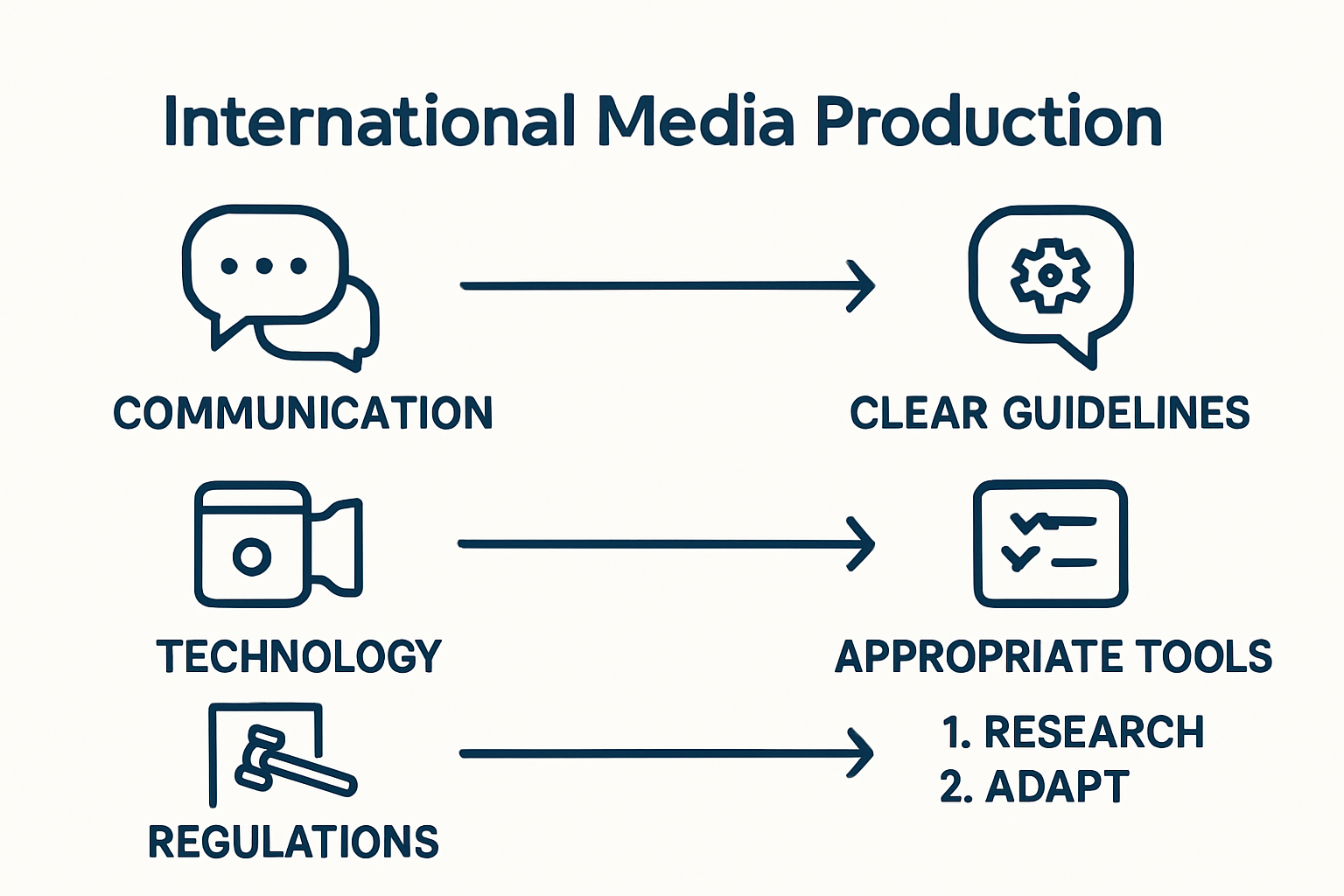The Importance of Production Planning for International Media
- info1419758
- Aug 17
- 9 min read

International media projects are captivating, mixing creative vision and global collaboration on a massive scale. Most people assume it all comes down to talent or flashy technology. In reality, 97 percent of marketing and advertising agencies face major creative campaign challenges because of poor planning. Discover how production planning quietly fuels international creative breakthroughs and why skipping it can cost more than just money.
Table of Contents
Quick Summary
Takeaway | Explanation |
Effective production planning enhances creativity. | Structured planning removes barriers, allowing creative teams to focus on innovation and high-quality content production. |
Leverage technology for seamless workflows. | Utilize digital tools for communication and collaboration across global teams to enhance efficiency and creativity. |
Manage cultural differences proactively. | Train teams on cultural intelligence and establish clear communication protocols to prevent misunderstandings in international projects. |
Thorough documentation is essential for success. | Comprehensive scripting and planning provide a roadmap that directs technical requirements and aligns creative visions. |
Flexibility is key to navigating challenges. | Adopt adaptive planning methodologies to quickly respond to unforeseen logistical and regulatory hurdles during production. |
How Production Planning Impacts Creative Success
Creative success in international media production is not a matter of chance but a direct result of meticulous planning and strategic management. The intricate landscape of global media projects demands a comprehensive approach that balances artistic vision with operational precision.
Strategic Framework for Creative Optimization
Production planning serves as the critical backbone that transforms creative potential into tangible outcomes. According to the Project Management Institute, 97% of marketing and advertising agencies encounter significant campaign challenges, with 47% reporting direct constraints on creativity. These statistics underscore the vital role of structured planning in unleashing creative potential.
Effective production planning creates an environment where creativity can flourish by removing logistical barriers and providing clear structural support. This approach allows creative teams to focus on innovation rather than getting bogged down by administrative complexities. By establishing clear timelines, resource allocations, and communication protocols, production planning enables artists and creators to channel their energy into producing high-quality content.
Bridging Creativity and Operational Excellence
The integration of project management principles directly impacts creative output. Research published in the South African Journal of Business Management highlights that structured project management practices help manage the inherent complexities of media production, leading to improved creative outcomes. This research demonstrates that planning is not about constraining creativity but about creating an optimal environment for creative expression.
Key elements of production planning that enhance creative success include:
Resource Allocation: Strategically distributing creative and technical resources to maximize potential
Timeline Management: Creating flexible yet structured schedules that allow creative breathing room
Risk Mitigation: Identifying and addressing potential challenges before they impact the creative process
Production planning transforms creative projects from potential chaos to synchronized excellence. It provides a roadmap that guides creative teams through complex international media landscapes, ensuring that innovative ideas are not just conceived but effectively realized.
Technology and Creative Planning
Modern production planning goes beyond traditional management techniques. The National Research Council’s report emphasizes how integrating information technology with structured planning can lead to significant creative and economic benefits. This technological approach enables more dynamic, responsive, and collaborative creative processes.
For international media productions, this means leveraging digital tools that facilitate real-time communication, resource tracking, and adaptive planning. Such technologies break down geographical barriers and create seamless workflows that support creative teams across different time zones and cultural contexts.
Ultimately, production planning is the invisible force that transforms creative potential into remarkable media experiences. It represents the delicate art of balancing artistic vision with operational precision, ensuring that international media projects not only meet but exceed creative expectations. Learn more about our comprehensive production planning strategies to understand how strategic planning can elevate your next creative project.
Key Benefits for International Video Projects
International video projects demand sophisticated planning strategies that extend far beyond traditional production approaches. These complex multimedia endeavors require comprehensive frameworks that address unique challenges and maximize creative and operational potential.
Strategic Cost Management and Resource Optimization
Effective production planning directly impacts financial efficiency in international video projects. According to the Office for Victims of Crime, detailed advance planning is crucial for preventing escalating costs and ensuring high-quality video production. By implementing robust preproduction strategies, teams can:
Budget Precision: Create accurate financial forecasts
Resource Allocation: Strategically distribute technical and creative resources
Risk Mitigation: Anticipate and minimize potential financial overruns
These approaches transform production planning from a administrative task into a strategic financial management tool. International video projects often involve multiple stakeholders, complex logistics, and cross-cultural considerations that can quickly inflate budgets without proper planning.
Enhanced Creative and Technical Performance
Research from the National Center for Biotechnology Information emphasizes that preproduction involves creating design strategies that optimize video production for audience learning capabilities. This insight reveals that production planning is not merely about logistical management but about crafting experiences that resonate with target audiences.
Key performance enhancements include:
Streamlined communication across international teams
Improved technical coordination
More efficient creative workflows
Reduced potential for misunderstandings or cultural miscommunications
Technology and Collaborative Workflows
Modern international video projects leverage advanced digital tools that transform traditional production planning. Explore our comprehensive approach to video production workflows to understand how technology bridges geographical and cultural gaps.
Digital collaboration platforms, cloud-based project management tools, and real-time communication technologies enable teams to:
Coordinate seamlessly across different time zones
Share resources instantaneously
Maintain consistent creative vision
Adapt quickly to emerging challenges
These technological integrations represent a quantum leap in international video project management. They replace traditional linear workflows with dynamic, responsive systems that can adjust in real-time to complex production demands.
Ultimately, production planning for international video projects is about creating a holistic ecosystem where creativity, technology, and strategic management converge. By implementing comprehensive planning strategies, teams can transform potential complexities into opportunities for extraordinary multimedia storytelling.
Common Challenges and How to Overcome Them
International media production presents a complex landscape of challenges that demand strategic thinking and proactive problem solving. Production teams must navigate intricate obstacles that can potentially derail even the most well-conceived projects.
Navigating Cultural and Communication Barriers
Cross-cultural communication represents one of the most significant challenges in international media production. Different cultural contexts, communication styles, and workplace expectations can create substantial friction. According to the Food and Agriculture Organization, effective planning involves strategic decision making that encompasses communication, coordination, and motivation across diverse teams.
To overcome these challenges, production teams must:
Cultural Intelligence Training: Develop comprehensive cross-cultural understanding
Clear Communication Protocols: Establish standardized communication frameworks
Translation and Localization Services: Ensure precise message transmission
Regular Cultural Sensitivity Workshops: Build mutual understanding and respect
Successful international productions recognize that communication is not just about language translation but about deep cultural comprehension and mutual respect.
Technical and Logistical Complexity
Technical infrastructure varies dramatically across different international contexts. Strategic production planning research emphasizes the importance of identifying strategic issues and developing responsive strategies that can adapt to varied technological landscapes.
Key strategies for managing technical challenges include:
Comprehensive equipment compatibility assessments
Redundant technical backup systems
Local technical support partnerships
Flexible technological infrastructure planning
Learn about our comprehensive approach to international production challenges to understand how professional teams mitigate potential technical disruptions.
Financial and Regulatory Navigation
International media productions must contend with complex financial and regulatory environments. Each country presents unique legal requirements, tax structures, and production regulations that can significantly impact project feasibility and budget.
Effective strategies for financial and regulatory management include:
Detailed pre-production legal consultations
Comprehensive international tax and permit research
Engagement with local legal and financial experts
Flexible financial modeling that accounts for potential regulatory shifts
Production teams must view financial and regulatory navigation as a dynamic process requiring continuous monitoring and adaptation. Successful international media projects are those that can pivot quickly while maintaining creative integrity and financial stability.
To provide a clear overview of the key strategies and methods for overcoming common international production challenges, the following table summarizes the main obstacles and the solutions highlighted in the article:
Challenge | Key Strategies for Overcoming |
Cultural & Communication Barriers | Cultural intelligence training, standardized communication protocols, localization services, sensitivity workshops |
Technical & Logistical Complexity | Equipment compatibility assessment, technical backups, local partnerships, flexible infrastructure planning |
Financial & Regulatory Navigation | Legal consultations, international tax/permit research, engagement with local experts, flexible financial modeling |
By anticipating challenges, developing robust contingency plans, and maintaining a flexible approach, production teams can transform potential obstacles into opportunities for innovative storytelling and cross-cultural collaboration. The key lies not in avoiding challenges but in developing the strategic capacity to navigate them effectively.

Best Practices for Effective Production Planning
Effective production planning is the cornerstone of successful international media projects. It requires a strategic approach that goes beyond traditional project management, integrating sophisticated methodologies to ensure seamless execution and creative excellence.
Comprehensive Scripting and Documentation
Documentation serves as the critical foundation of successful production planning. According to research published in the National Center for Biotechnology Information, detailed scripting significantly enhances production efficiency by reducing recording errors and creating valuable reference materials. A comprehensive script does more than outline dialogue it provides a roadmap for:
Technical equipment requirements
Location logistics
Talent coordination
Creative vision alignment
Potential contingency scenarios
Professional production teams recognize that a meticulously crafted script is not a constraint but a flexible framework that guides creative execution while maintaining operational precision.
Below is a summary table highlighting the main elements of comprehensive scripting and documentation discussed in the article. This table organizes the key areas a detailed production script should cover, serving as both a reference guide and a checklist for production teams:
Script Element | Purpose |
Technical Equipment Requirements | Ensure the right technical resources are allocated |
Location Logistics | Plan shooting locations and associated needs |
Talent Coordination | Organize casting and scheduling |
Creative Vision Alignment | Maintain consistent artistic goals |
Contingency Scenarios | Prepare for unforeseen challenges |
Strategic Collaboration and Network Mapping
International media production demands sophisticated collaboration strategies. Research analyzing global film production networks reveals the critical importance of strategic partnerships. Countries like the United States, China, and England emerge as central nodes in successful international media collaborations.
Key strategies for effective collaborative planning include:
Identifying complementary skill sets across international teams
Establishing clear communication protocols
Creating shared digital workspaces
Developing cross-cultural understanding
Explore our insights on managing global media production teams to understand how professional networks transform complex projects into seamless experiences.
Robust Information and Progress Tracking
The Food and Agriculture Organization emphasizes the necessity of maintaining comprehensive production records. According to their guidance on effective planning, establishing a robust information system enables organizations to:
Monitor project progress in real-time
Identify potential issues before they escalate
Ensure alignment with production goals
Create accountability across international teams
Modern production planning leverages advanced digital tools that provide unprecedented visibility into complex multimedia projects. These systems go beyond traditional tracking mechanisms, offering:
Real-time collaborative dashboards
Predictive performance analytics
Automated resource allocation
Comprehensive risk management frameworks
The most successful international media productions view planning not as a rigid process but as a dynamic, adaptive strategy. By combining meticulous documentation, strategic collaboration, and advanced tracking technologies, production teams can transform potential complexity into a competitive advantage.
Ultimately, effective production planning is an art form that balances creativity with operational excellence. It requires a holistic approach that respects both the technical and artistic dimensions of international media production.

Frequently Asked Questions
What is the importance of production planning in international media?
Effective production planning is essential for international media projects as it enhances creativity, optimizes resource allocation, and ensures efficient communication across diverse teams. Meticulous planning creates an environment where creative talents can focus on high-quality content production without being bogged down by logistical challenges.
How does technology facilitate production planning for global projects?
Technology plays a crucial role in international production planning by enabling real-time communication, resource tracking, and collaboration among teams spread across different locations. Digital tools enhance workflow efficiency, allowing creative professionals to adapt quickly to challenges while maintaining a unified vision.
What are some common challenges faced in international media production?
International media productions often encounter challenges such as cultural and communication barriers, technical and logistical complexities, and navigating varied financial and regulatory environments. Understanding these challenges helps teams proactively develop strategies to mitigate them, ensuring successful project execution.
What best practices should be followed for effective production planning?
Best practices for effective production planning include comprehensive scripting and documentation, strategic collaboration and network mapping, and robust information tracking systems. These practices ensure a structured approach that accommodates the unique demands of international media while fostering creativity and operational excellence.
Elevate Your International Production with True Swiss Expertise
Are global production plans keeping you up at night? Missing permits, unreliable crew sourcing, or location headaches can sabotage even the most creative projects. As covered in this article, effective production planning is the difference between chaotic setbacks and creative freedom. You need a partner who knows how to navigate cross-cultural barriers, compliance, and the unpredictable logistics that come with filming abroad. That is why working with professionals who anticipate every detail is so important.

Do not let production challenges dilute your vision. Tap into over twenty years of local expertise at Video Production Switzerland. We deliver all-in-one video production solutions that handle permits, gear, crew, and flawless coordination—so your team can focus on telling a powerful story. Ready to experience seamless, reliable execution for your next Swiss media project? Start your free consultation today and see how effortless international production can feel.
Recommended

Comments